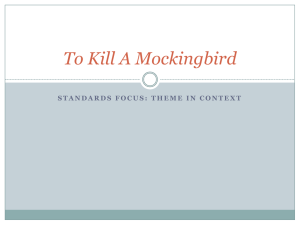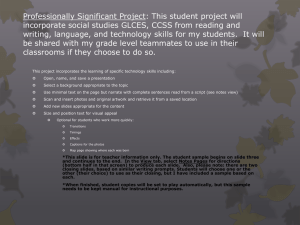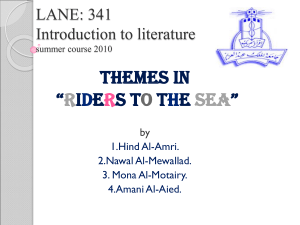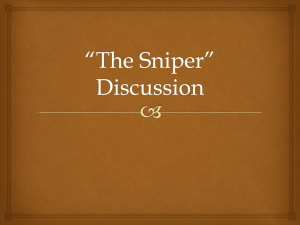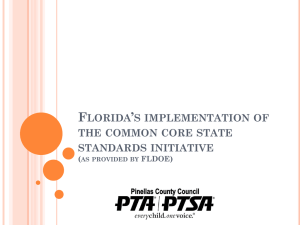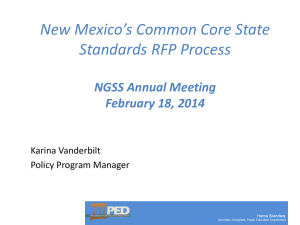L - Florida Standards
advertisement
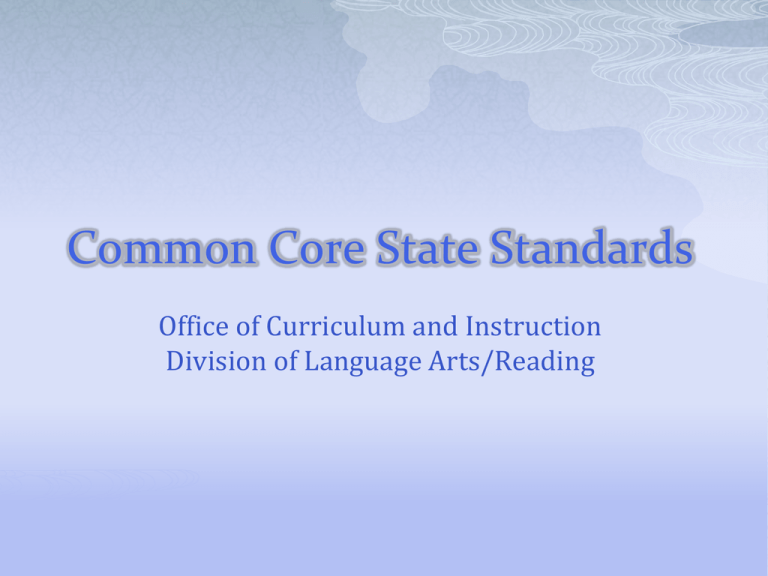
Common Core State Standards Office of Curriculum and Instruction Division of Language Arts/Reading Welcome Back! What’s New? Common Core State Standards New goals for K-2 in the K-12 CRRP FCAT Writing Pacing Guides Civics Benchmarks Job Expectations School Site Reading Coach Meeting Florida’s Common Core State Standards Implementation Timeline Year/Grade Level 2011-2012 K FL 1 L 2 L 3-8 L 9-12 L 2012-2013 FL FL L L L 2013-2014 FL FL FL BL BL FL FL FL FL FL CCSS fully implemented 2014-2015 CCSS fully implemented and assessed F - full implementation of CCSS for all content areas L - full implementation of content area literacy standards including: (1) text complexity, quality and range in all grades (K-12), and (2) CCSS Literacy Standards in History/Social Studies, Science, and Technical Subjects (6-12) B - blended instruction of CCSS with Next Generation Sunshine State Standards (NGSSS); last year of NGSSS assessed on FCAT 2.0 K-12 CRRP Achievement Goals for K-2 70% of students in Kindergarten-2nd grade will: Score 85% or higher in the Broad Screen/Progress Monitoring Tool section of the FAIR. Score in the 40th and 60th percentile in the Vocabulary Task. Respond to at least 4 out of 5 questions correctly on the Listening Comprehension (Kindergarten) or Reading Comprehension (Kindergarten-Grade 2) Task. Read the target passage for Assessment Period 3 AP3 with 95% accuracy in grades 1 and 2 and with fluency as follows: Grade 1- 60 words correct per minute Grade 2- 90 words correct per minute Score in the 40th-60th percentile in the Spelling Task (Grade 2 only) FCAT Writing New Assessment Focus 2014-2015 – Students will be “writing to a source” Read complex text and then be prompted to present a clear and coherent analysis in writing. Demonstrating a command of English language conventions. FCAT Writing Timeline Spring 2012 – Scoring will include expanded expectations in The correct use of standard English conventions, and The quality of details (relevant, logical and plausible support) “Reponses will continue to be scored holistically, as draft writing, but scoring will be more stringent.” FCAT Writing Spring 2013 Modes of writing will remain the same (narrative, expository) Rubrics will be customized to evaluate the response to the writing task, including the purpose and audience (genre specific) New calibration scoring guides will be developed for each grade level and writing purpose Pacing Guides Completely new for grades K and 1 (Reading and Writing) Civics benchmarks added in all grades Infused into Houghton Mifflin anthology “Hot” links added for Writing resources (primary) Job Expectations School site Reading Coach Compact/Action Plans Facilitate planning in K and 1st grade for CCSS implementation Initiate integration of complex text (quality and range) in all grades Ensure an understanding of the importance of text reading efficiency and its impact on reading comprehension Reading Coach Meetings Everyone will plan and demonstrate a model lesson using an exemplar text at each of the Reading Coach Meetings Purpose of Common Standards To improve U.S. educational attainment by focusing schools on higher learning goals To standardize educational opportunity To focus attention on fewer, higher, better standards (more on outcomes than on processes) Curriculum Coverage & Structure English Language Arts Mathematics No other areas of the curriculum slated for inclusion at this time (Achieve is now working on Science) Smaller number of college and career readiness standards organized within themes/categories Backmapping (K-12) to show how attainment can be accomplished. What Makes These Standards Special? Independent analysis indicates that they are more rigorous/demanding than the standards of 37 States Internationally benchmarked Include all grades (K-12) and emphasize disciplinary literacy Increased stress on expository text, critical reading, and use of technology Recognizes importance of text difficulty and the value of canonical text English Language Arts Reading (foundational skills K-3) Reading (reading comprehension) Writing Speaking and Listening Language (conventions and vocabulary) Reading Themes/Categories Reading (comprehension) Literary Informational Elementary History Science Secondary 10 standards divided among: Key ideas and details Craft and structure Integration of knowledge and ideas Range and level of text complexity Writing Themes and Categories Text types and purposes Production and distribution of writing Research to build knowledge Range of writing Speaking & Listening Themes/Categories Comprehension and collaboration Presentation of knowledge and ideas Language Themes/Categories Conventions of writing and speaking Vocabulary acquisition and use Foundational Reading Skills Phonics and word recognition Fluency Backmapping: Reading Key Ideas With prompting and support, ask and answer questions about details/information and events in literature and informational text (K) Ask and answer questions about key details/information and events in literature and informational text (1) Ask and answer such questions as who, what, where, when why, and how to demonstrate understanding of key details/information and events in literature and informational text (2) Ask and answer questions to demonstrate understanding, explicitly using the text (literary and informational) as the basis for answers (3) Backmapping: Reading Key Ideas (cont.) Draw on details and examples from text to support statements about the literary and informational texts (4) Quote from literary and informational texts to support statements about the text (5) Cite specific textual evidence to support analysis of what the literary and informational texts say explicitly as well as inferences drawn from texts (6) What Do You Notice About the Progression? The skills become more specific and demanding Recognition of details as a support to broader interpretation of text Text difficulty (including ambiguity) is a critical criterion in determining progression There is an emphasis on informational text from the earliest grades The inclusion of science and history/social studies The strong stress on using information as evidence Text Complexity The independence of skills and text complexity Emphasis on harder text Three part model for measurement Quantitative dimensions Qualitative dimensions Reader and task considerations Exemplar Text Text samples provided to demonstrate the level of complexity and quality the CCSS require (Appendix B) Choices serve as guideposts in helping teachers select similar complexity, quality and range for their own classrooms They are not a partial or complete reading list. STRAND/BODY OF KNOWLEDGE: Language Arts /Reading TOPIC: Review Theme 1 Review Skills/Administer Theme Skills Test *Exemplar Text: Appendix B (CCSS) Common Core State Standards (NGSSS) RF.K.1a Follow words from left to right, top to bottom, and page by page. (LA.K.1.1.6) RF.1.1a Recognize the distinguishing features of a sentence (first word, capitalization, ending punctuation). (LA.1.3.4.2, LA.1.3.4.6) RF.K.2a Recognize and produce rhyming words. (LA.K.1.2.3) L.1.1a Print All upper-and lowercase letters. (LA.1.5.1.1) RF.1.4b Read on-level text orally with accuracy, appropriate rate, and expression on successive readings. RI.1.2 Identify the main topic and retell key details of a text. (LA.1.1.7.3, LA.1.1.7.4, LA.1.1.7.7) SL.1.1a Follow agreed upon rules for discussion (e.g., listening to others with care, speaking one at a time about the topics and texts under discussion). (LA.1.5.2.6) SL.1.1b Build on others’ talk in conversations by responding to the comments of others through multiple exchanges. (LA.1.5.2.6) SL.1.2 Ask and answer questions about key details in a text read aloud or information presented orally or through other media. (LA.1.5.2.3 ) Pacing Traditional Block Houghton Mifflin Instructional Routines Daily Message (RF.K.3a,RF.K.1a, RF.1.1a, RF.1.3g, RF.K.1c, L.1.2b) Daily Phonemic Awareness (RF.K.2a, RF.K2b, RF.1.2b, RF.1.3d, RF.1.2) Phonics: Connect to Spelling and Writing (L.1.1a) Daily Independent Reading(RF.1.4b) Sharing the Big Book: Responding (RL.1.1, RL.1.2, RL.1.3,SL.1.1a, SL.1.1b, SL.1.2, RI.1.7, RL.1.1, RL.1.7, RL.1.9, RF.1.4a ) Big Book and Anthology selections (RI.1.7, RF.1.4b,) Comprehension/Critical Thinking (RL.1.1, RL.1.3 Revisiting the text: Concepts of Print (RF.K.1c, RF.1a) Re-Reading the Big Book (RF.1.4b,RF.1.4a) Reading the Anthology (RF.1.4a, RL.1.1, RL.1.2, RL.1.7 RF.K.1a, RF.1.4b RF.1.3b) Reading the Little Book (RF.1.4b) Phonics (RF.1.2b, RF.1.3b, L.1.1a) Phonemic Awareness: Blending (RF.1.2b) Phonics : Connect to Spelling (RF.1.2b, RF.1.2c , RF.1.3b ) Objectives The student will review concepts of print and phonics skills. be able to read grade level text with fluency and accuracy. be able to identify the main idea and beginning, middle and end of a text. recognize consonants m,n,f,p, s,c,b,r,h,g,and the sounds they represent. blend onset and rime associate the short a sound with the letter a. read words with m,n,f,p, s,c,t,–at and an. review words in the an and at family on the word wall sequence story events. read and write go, on, the. contribute sentences about a topic to write a class story. point out spaces between words clap words into Alignment to FAIR and SAT 10 L.1.1a Print All upper-and lowercase letters (FAIR: Letter Sound Knowledge) RF.1.4b Read on-level text orally with accuracy, appropriate rate, and expression on successive readings.(FAIR: Reading Comprehension) RI.1.2 Identify the main topic and retell key details of a text (FAIR: Reading Comprehension and SAT 10) RF.1.2b Orally produce single-syllable words by blending sounds (phonemes), including consonant blends. (FAIR: Phoneme Blending) RF.1.3b Decode regularly spelled one-syllable words. (FAIR: Word Building-Consonants) SL.1.2 Ask and answer questions about key details in a text read aloud or information presented orally or through other media. (FAIR: Listening Comprehension) RF.1.4a Read on-level text with purpose and understanding. (FAIR: Reading Comprehension 4 days Date 09/26/1109/30/11 INSTRUCTIONAL TOOLS Core Text Book: Houghton Mifflin: Resources: All Together Now Vocabulary: Elements of Reading Vocabulary Houghton Mifflin Vocabulary Readers Write Time for Kids Technology: Audio Tapes/CDs Get Set to Read Ticket to Read Destination Reading/ Riverdeep SuccessMaker www.eduplace.com www.bookadventure.org Strategies: Refer to ‘Meeting Individual Needs’ in Houghton Mifflin TE for Above, On, & Below Level Differentiation. *Exemplar Text: Choose an exemplar text from Appendix B in the CCSS to apply reviewed standards and tested skills. List text title on the Instructional Focus Calendar. District Pacing Guide Grade Level or Course Title – Grade K STRAND/BODY OF KNOWLEDGE: Pacing Language Arts/Writing Traditional Block TOPIC: Shared Research – Class Powerpoint/Big Book on a Topic COMMON CORE STATE STANDARDS (CCSS) ESSENTIAL CONTENT W.K.7 Participate in shared research and writing projects (e.g., explore a number of books by a favorite author and express opinions about them). (LA.K.6.2.2, LA.K.6.2.3, LA.K.3.2.1) Research a single topic together W.K.5 With guidance and support from adults, respond to questions and suggestions, from peers and add details to strengthen writing as needed. (LA.K.3.3.1) Determine various subtopics to learn about SL.K.2 Confirm understanding of a text read aloud of information presented orally or through other media by asking and answering questions about key details and requesting clarification if something is not understood. (NEW & LA.K.5.2.2) Select various books on the same topic (refer to suggested mentor text list) After read alouds, reread and take shared notes on different posters for each subtopic applicable Draft sentences based on each subtopic’s chart/notes SL.K. 5 Add drawings or other visual displays to descriptions as desired to provide additional detail. (NEW) Revise & Edit for: Capital letters Punctuation Spelling Sentence Combining Sentence Variety SL.K.6 Speak audibly and express thoughts, feelings, and ideas clearly. (LA.K.5.2.5) With the assistance of the students, produce a Powerpoint to share the final format of the presentation L.K.1 Demonstrate command of the conventions of standards English grammar and usage when writing or speaking. Utilize the created Powerpoint to teach other kindergarten classes about the topic L.K.1f Produce and expand complete sentences in shared language activities. (LA.K.3.2.2) Print small versions the Powerpoint so each student has their own copy Date 8 3/26/12-4/6/12 OBJECTIVES INSTRUCTIONAL TOOLS The student will be able to: Participate in identifying a single topic to completed shared research with the teacher. Suggest and select various books and resources on the topic being researched. Identify subtopics to learn about focusing on the topic to chart pictures and notes about. Listen to the teacher read various resources about the shared research topic. Listen to many different rereadings of various resources and chart notes by subtopics. Gather all notes chart on one subtopic and draft the notes in complete sentences before writing about the next subtopic. Add illustrations to each subtopic to make it more visual to understand. Assist with revisions and editing of the draft. Create a Powerpoint, with the assistance of the students, to publish the information learned. Obtain a copy of the final Powerpoint in a smaller version for rereading. Assist with instructing another kindergarten class based on the concept learned utilizing the Powerpoint. Mentor Text: Suggest finding mentor text related to the science concepts previous learned or currently working on: 1. 2. 3. 4. 5. 6. 7. 8. 9. 10. 11. 12. 13. 14. 15. Five Senses & Related Body Parts Properties of Matter Changing Matter’s Shape Forces & Changes in Motion: Push or Pull Ways Objects Move Sound Law of Gravity Day and Night Sky Repeating Patterns Big and Small Objects in the Sky Similarities and Differences in Plants and Animals Characteristics of Animals Characteristics of Plants Plant and Animals Comparisons Animal and Plant Portrayals Professional Text: Interactive Writing: How Language & Literacy Come Together By Andrea McCarrier, Gay Su Pinnell, & Irene C. Fountas Nonfiction Writing: Procedures and Reports by Lucy Calkins & Laurie Pessah Reading 2011-2012 Pacing Guide K Year-at-a Glance Quarter 1 Grade K Week Days Weeks 1 5 8/22/11-8/26/11 2 5 8/29/11-9/02/11 3 4 9/05/11-9/09/11 4 5 9/12/11-9/16/11 5 5 9/19/11-9/23/11 6 4 9/26/11-9/30/11 7 5 10/03/11-10/07/11 8 5 10/10/11-10/14/11 9 5 10/17/11-10/21/11 10 4 10/24/11-10/28/11 Title Theme 1: Look at Us !: Listening to a story: Goldilocks and the Three Bears; The Three Billy Goats Gruff; The Tale of the three Little Pigs; Henny Penny Theme 1: Look at Us !: Listening to a story: The Little Engine that Could; The Tortoise and the Hare; The Lion and the Mouse; The Enormous Turnip Theme 1: : Look at Us !: Now I’m Big; Mice Speak, We Speak,;Let’s Play Theme 1: Look at Us! : The Gingerbread Man; Here are My Hands; How Do You Feel? Theme 1: Look at Us!: Review Skills/Administer Theme Skills Test *Exemplar Text Theme 2: Colors All Around: I Need a Lunch Box; I Went Walking; What’s My Favorite Color? Theme 2: Colors All Around: Caps of Many Colors; In the Big Blue Sea; What Do You Do, Norbert Wu? Theme 2: Colors All Around: Review Skills/Administer Theme Skills Test *Exemplar Text Theme 3: We’re a Family: Jonathan and His Mommy; Tortilla and Lullabies; Families Theme 3: We’re a Family: Jonathan and His Mommy; Tortilla and Lullabies; Families Year 1 CCSS Implementation School-site Follow-up Share implementation timeline and goals of CCSS with Literacy Leadership team. Provide an opportunity for trained K and first grade teachers to share and plan with grade level peers Partner with the Reading Coach to provide support to teachers for implementation beginning with a review of the new pacing guides with all K and 1 teachers Monitor implementation including, cognitive rigor in instruction, through daily classroom visits by administrative team.



